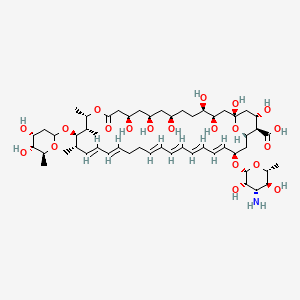Nystatin A3
Nystatin A3 is a lipid of Polyketides (PK) class. Nystatin a3 is associated with abnormalities such as Mycoses, Candidiasis of the genitals and Gigantism. The involved functions are known as Drug Interactions, Process, Synthesis, Fermentation and Anabolism. Nystatin a3 often locates in Cell membrane, Membrane, Protoplasm, Entire oral cavity and integral to membrane. The associated genes with Nystatin A3 are Gene Clusters. The related lipids are Sterols, 1,2-oleoylphosphatidylcholine, Membrane Lipids, DOPE and N-caproylsphingosine.
Cross Reference
Introduction
To understand associated biological information of Nystatin A3, we collected biological information of abnormalities, associated pathways, cellular/molecular locations, biological functions, related genes/proteins, lipids and common seen animal/experimental models with organized paragraphs from literatures.
What diseases are associated with Nystatin A3?
Nystatin A3 is suspected in Mycoses, Candidiasis of the genitals, Gigantism and other diseases in descending order of the highest number of associated sentences.
Related references are mostly published in these journals:
| Disease | Cross reference | Weighted score | Related literature |
|---|
Possible diseases from mapped MeSH terms on references
We collected disease MeSH terms mapped to the references associated with Nystatin A3
PubChem Associated disorders and diseases
What pathways are associated with Nystatin A3
There are no associated biomedical information in the current reference collection.
PubChem Biomolecular Interactions and Pathways
Link to PubChem Biomolecular Interactions and PathwaysWhat cellular locations are associated with Nystatin A3?
Visualization in cellular structure
Associated locations are in red color. Not associated locations are in black.
Related references are published most in these journals:
| Location | Cross reference | Weighted score | Related literatures |
|---|
What functions are associated with Nystatin A3?
Related references are published most in these journals:
| Function | Cross reference | Weighted score | Related literatures |
|---|
What lipids are associated with Nystatin A3?
Related references are published most in these journals:
| Lipid concept | Cross reference | Weighted score | Related literatures |
|---|
What genes are associated with Nystatin A3?
Related references are published most in these journals:
| Gene | Cross reference | Weighted score | Related literatures |
|---|
What common seen animal models are associated with Nystatin A3?
There are no associated biomedical information in the current reference collection.
NCBI Entrez Crosslinks
All references with Nystatin A3
Download all related citations| Authors | Title | Published | Journal | PubMed Link |
|---|---|---|---|---|
| Zhang D et al. | Residual detection of buparvaquone, nystatin, and etomidate in animal-derived food products in a single chromatographic run using liquid chromatography-tandem mass spectrometry. | 2017 | Food Chem | pmid:28763970 |
| Lima JF et al. | Porosity of temporary denture soft liners containing antifungal agents. | 2016 Sep-Oct | J Appl Oral Sci | pmid:27812615 |
| Chanthick C et al. | Caveolae-mediated albumin transcytosis is enhanced in dengue-infected human endothelial cells: A model of vascular leakage in dengue hemorrhagic fever. | 2016 | Sci Rep | pmid:27546060 |
| Ellepola AN et al. | Impact of short-term exposure of antifungal agents on hemolysin activity of oral Candida dubliniensis isolates from Kuwait and Sri Lanka. | 2016 | J Investig Clin Dent | pmid:26059506 |
| Streekstra H et al. | Fungal strains and the development of tolerance against natamycin. | 2016 | Int. J. Food Microbiol. | pmid:27589020 |
| Sardi JC et al. | Synthesis, antifungal activity of caffeic acid derivative esters, and their synergism with fluconazole and nystatin against Candida spp. | 2016 | Diagn. Microbiol. Infect. Dis. | pmid:27638348 |
| Kinoshita H et al. | Cryptic antifungal compounds active by synergism with polyene antibiotics. | 2016 | J. Biosci. Bioeng. | pmid:26323525 |
| Hashemy SI et al. | Oxidative stress factors and C-reactive protein in patients with oral lichen planus before and 2 weeks after treatment. | 2016 | J. Oral Pathol. Med. | pmid:26058710 |
| Marmiroli M et al. | A genome-wide nanotoxicology screen of Saccharomyces cerevisiae mutants reveals the basis for cadmium sulphide quantum dot tolerance and sensitivity. | 2016 | Nanotoxicology | pmid:25938282 |
| Oncel MY et al. | Author's Reply: role of probiotics in prevention of Candida colonization and invasive candidiasis. | 2016 | J. Matern. Fetal. Neonatal. Med. | pmid:25777578 |
